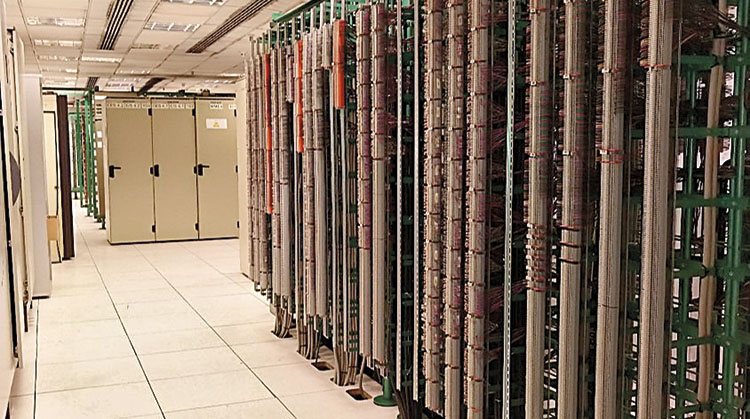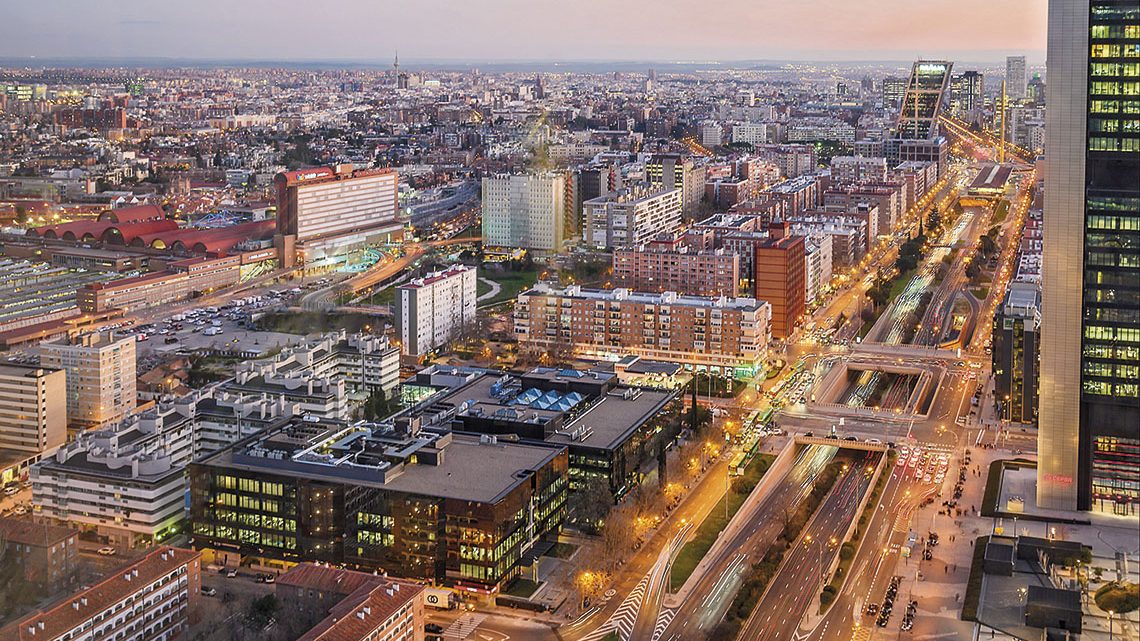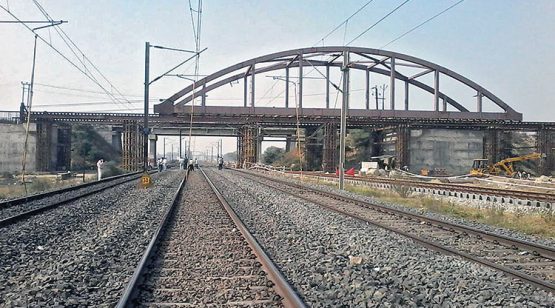The development of modern Madrid is closely linked to that of its railway infrastructure. The increase in population forced the city to expand northwards at the beginning of the 20th century, and the construction of new stations, lines and railway connections were planned and implemented at the same time. Today, the capital’s main urban axis runs between the two major stations, Chamartín in the north and Atocha in the south, connected on the surface by the Prado, Recoletos and Castellana promenades and underground by three tunnels: two for commuter trains and one for high-speed trains, which has not yet opened.
Of the three tunnels, Recoletos was the first to be opened, in 1967, at the same time that the city was growing along the new urban corridor. With the opening of the subway, which had two stops –Recoletos and Nuevos Ministerios– development began on what starting the 80s would be Madrid’s commuter rail network, the largest in the country, which today carries more than 900,000 passengers every day.
The Recoletos tunnel is still the busiest in the country today: 470 trains and 200,000 passengers pass through it each work day
Recoletos is still the busiest railway tunnel in the country today: 470 trains and 200,000 passengers pass through it every work day, for a total of almost 3,300 journeys each week. 98% of this traffic corresponds to the Madrid commuter rail lines C-1, C-2, C-7, C-8 and C-10 –the rest runs through the Sol tunnel– along with some twenty medium- and long-distance trains per day.
Although improvement works were carried out in 2008, 2009 and 2012, the intensive use of this infrastructure after more than half a century in service made it necessary to undertake a more thorough renovation of the underground system. On behalf of Adif, Ineco provided the project and management of the works, as well as technical assistance, which required the closure of the tunnel between June and November 2019; on 17 November, the 7.3 kilometres tunnel was reopened to traffic.
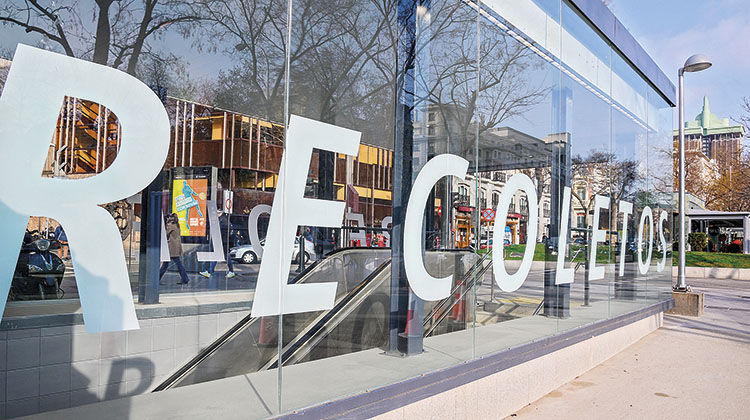
Recoletos Station. / PHOTO_ELVIRA VILA (INECO)
The works were carried out against the clock in order to minimise the impact on Madrid’s railway network, which began operations in the mid-19th century. The first railway line in the capital, initially for the exclusive use of the Royal Family, linked Madrid with the Royal Palace of Aranjuez and was opened in 1851. It started from a stop (or ‘boarding platform’ as it was known at the time) that would later become the Mediodía station, today’s Atocha station.
The development of the railway parallels the growth of the city, which until the end of the 18th century was enclosed within walls with their corresponding puertas or ‘gates’, with the Puerta de Alcalá and Puerta de Toledo, for example, surviving up to the present day. The last wall, built by King Felipe IV, was demolished in 1868, making it possible to expand the city.
The TUNNEL layout follows the main urban corridor of Madrid, from Atocha to Chamartín, under the great boulevards of the capital
The first urban development plans, at the end of the 1920s, proposed growth along a large new north-south avenue that would structure the city, the Paseo de la Castellana. This planning included, among other installations, a new railway network of which the Recoletos tunnel was a part, which was designed and planned in 1933 following the same alignment of the future Paseo de la Castellana. The outbreak of the Spanish Civil War (1936-1939) and the economic difficulties of the post-war period paralysed these and many other projects for years, including the underground, which finally opened four decades later.
At the beginning of the new millennium, the growth in the demand for transport drove the expansion of the commuter rail network: In 2008, a second tunnel, Atocha-Sol-Nuevos Ministerios-Chamartín, was opened. A third tunnel, also between Atocha and Chamartín, which has already been completed, will be dedicated exclusively to high-speed trains, connecting all of the lines in the network.
ATOCHA (94,5M passengers/year*)
Built on the former Mediodía station, the existing railway complex, the largest in Spain, was opened in 1992 along with the Madrid-Seville high-speed line. It consists of two stations, the commuter station and the high-speed station. It is located in the Glorieta del Emperador Carlos V, where the Paseo del Prado begins and continues north to the Plaza de Colón. The three major national museums are located in this area: the Prado, the Museo Nacional Centro de Arte Reina Sofía and the Thyssen Museum.
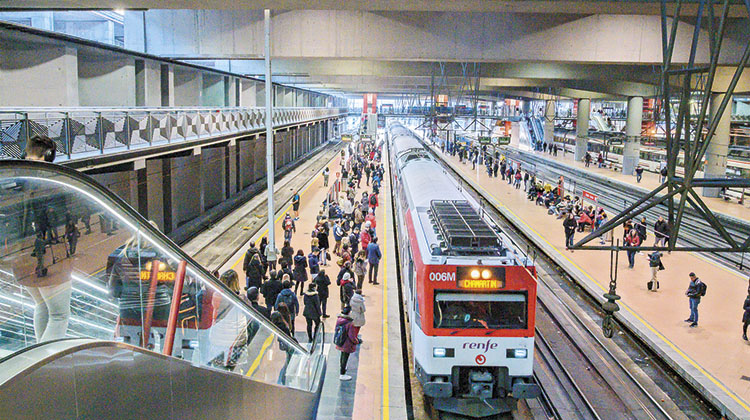
Atocha Station. / PHOTO_ELVIRA VILA (INECO)
RECOLETOS (9,3M passengers/year*)
In the 16th and 17th centuries, this was an area with orchards known as Prado de Recoletos, in reference to the convent of Augustinian friars, located on the site now occupied by the National Library and the Archaeological Museum. The Paseo de Recoletos begins at the Plaza de Cibeles – with its famous fountain, a symbol of Madrid, and which houses, among others, the Palacio de Telecomunicaciones and headquarters of the City Council – and ends at Colón. In the 1960s and 1970s many old palaces and buildings were demolished and replaced by modern buildings.
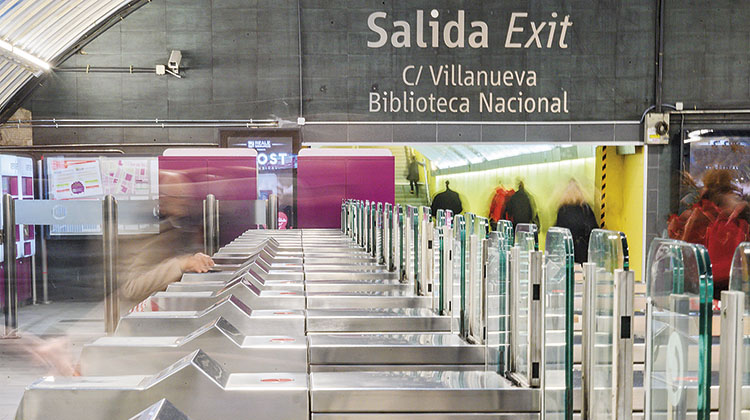
Recoletos Station. / PHOTO_ELVIRA VILA (INECO)
NUEVOS MINISTERIOS (35,1M passengers/year*)
In the 1930s the city’s growth towards the north was first planned, along a large avenue, the Paseo de la Castellana, which opened to traffic in 1952, and Azca, a new residential, commercial and entertainment area. The Nuevos Ministerios complex was built alongside it and the first underground suburban station was opened here in 1967, located under the central courtyard. After several extensions, it has now become a large interchange, connecting to three metro lines and seven suburban lines.
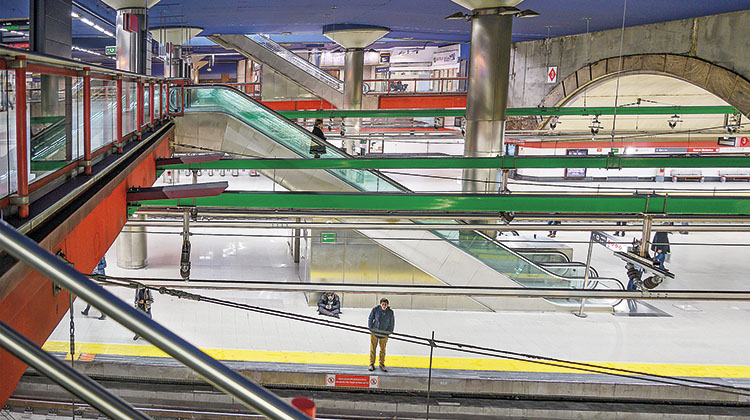
Nuevos Ministerios Station. / PHOTO_ELVIRA VILA (INECO)
CHAMARTÍN (24,2M passengers/year*)
The route of the tunnel is separated from the axis of the Paseo de la Castellana until it reaches this station, which gets its name from the former village of Chamartín de la Rosa on which it is located. The first station was opened in 1967, and eight years later the new railway terminal was designed by the architects Alonso, Corrales and Molezún, along with the engineer Rafael Olaquiaga. In 2008, it was renovated to adapt to high-speed trains and connect to the new Sol tunnel. The next major remodelling has already begun with a view to the commissioning of the third exclusive high-speed tunnel between Atocha and Chamartín.
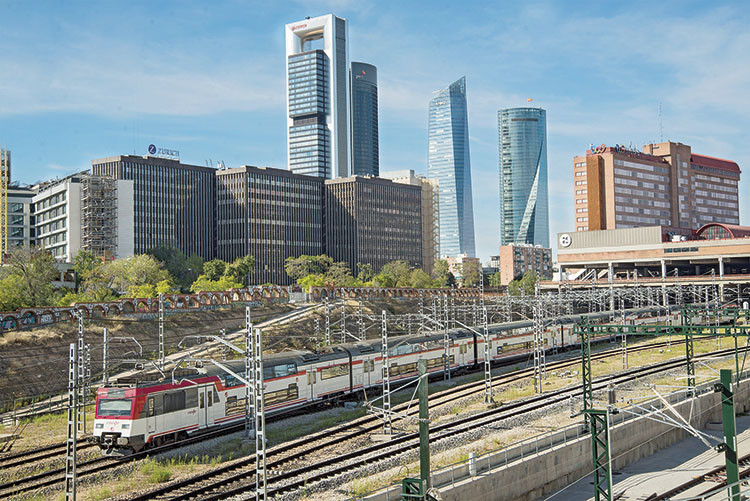
Chamartín Station. / PHOTO_ELVIRA VILA (INECO)
How to rejuvenate a half-century old tunnel
The renovation required completely removing all of the tracks, with ballast and wooden sleepers, and replacing them with slab track, which requires less maintenance. In addition, flexible overhead lines were replaced with a rigid catenary system, which is more robust and reliable: this type of catenary on DC electric lines shows less wear and tear, and if any of its elements need to be replaced, this can be done automatically with specialised machinery, reducing the possibility of incidents. The signalling systems were also modernised. 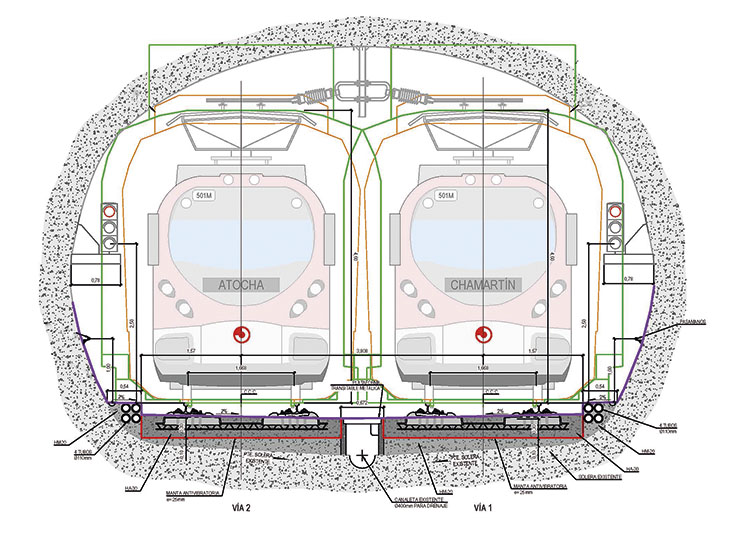 For the above reasons, it was necessary to close the tunnel and work continuously, 24 hours a day, for six months, in order to reopen the infrastructure as soon as possible. In this project, the most important one in the Madrid Commuter Plan, Ineco participated by preparing the construction project for the most important action, track and overhead line renovation, for Adif, and by managing and providing technical assistance for works on the entire line.
For the above reasons, it was necessary to close the tunnel and work continuously, 24 hours a day, for six months, in order to reopen the infrastructure as soon as possible. In this project, the most important one in the Madrid Commuter Plan, Ineco participated by preparing the construction project for the most important action, track and overhead line renovation, for Adif, and by managing and providing technical assistance for works on the entire line.
Recoletos Station: improvements in safety, accessibility and interior
At the same time, Ineco also drafted several projects for Adif and managed the work on various remodelling projects in the Recoletos station, which will be completed by the end of 2020:
- Safety and evacuation improvements, with the reopening and conditioning of two existing exits to outside, in addition to the two that were operational; the installation of the compartmentalisation elements (such as doors, gates, etc.) and ventilation to make the platform cavern independent from the station lobby and to configure all the evacuation routes as continuous protected enclosures, and all the additional actions required: lighting, signposting, fire detection and extinguishing installations, protection of structures, etc. The structural reinforcement of three cross galleries above the tracks was also carried out. The project also includes the design and installation of a new surface transformer station for the supply of electricity.
- In terms of accessibility, two projects were drafted, one to adapt the height of the platform to current regulations by minimizing the horizontal separation, and another for the installation of three lifts to connect the platforms to each other and to street level, which are expected to be ready by the end of 2020. The access corridors to Prim and Villanueva streets were also remodelled and are now completely enclosed in glass.
- Renovation of the platform vault: elimination of the suspended ceiling, improvement of ventilation, replacement of the floor and wall coverings and installation of new benches and ischiatic supports.
Track and overhead line renovation: The making-of step by step
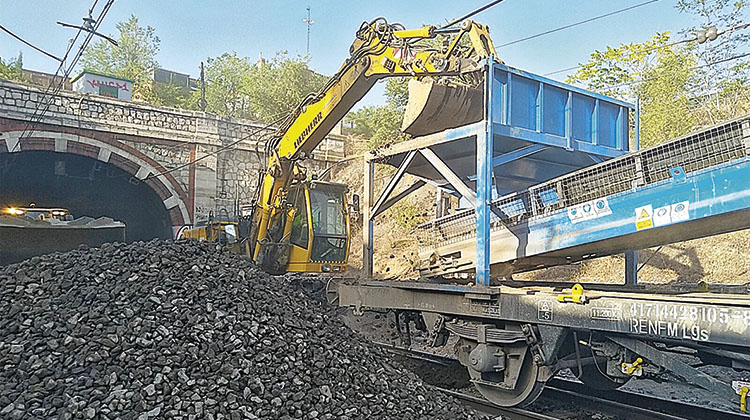 2. The ballasted track was lifted and replaced by slab track. The picture shows the new bi-block sleepers, type BP-SO, ready for the pouring of the slab track.
2. The ballasted track was lifted and replaced by slab track. The picture shows the new bi-block sleepers, type BP-SO, ready for the pouring of the slab track. 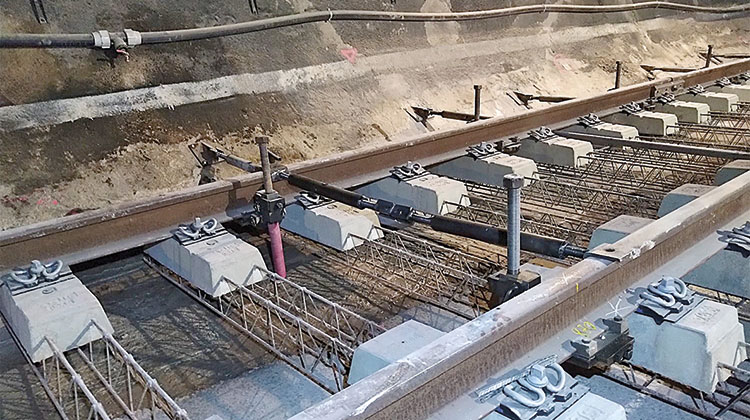 3. The concrete was poured directly in order to create the slab. In total, 23,000 m3 of reinforced concrete was used.
3. The concrete was poured directly in order to create the slab. In total, 23,000 m3 of reinforced concrete was used. 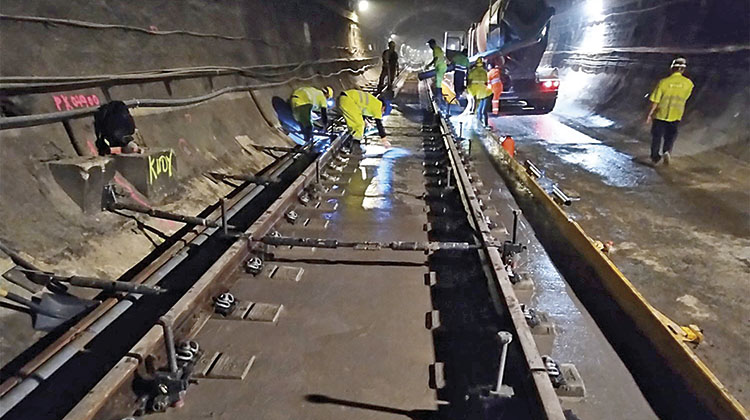 4. Machinery for the correct positioning of the track. Throughout the tunnel, 29,400 m of rails were installed in 288-metre long bars.
4. Machinery for the correct positioning of the track. Throughout the tunnel, 29,400 m of rails were installed in 288-metre long bars. 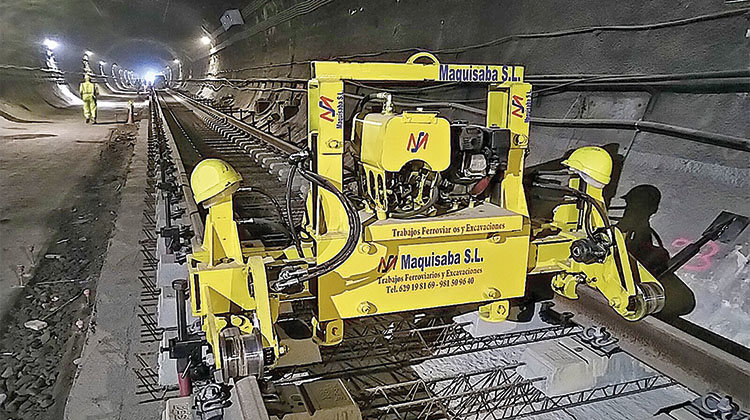 5. Pouring of track 2 from track 1, already completed, with a three-tank train.
5. Pouring of track 2 from track 1, already completed, with a three-tank train. 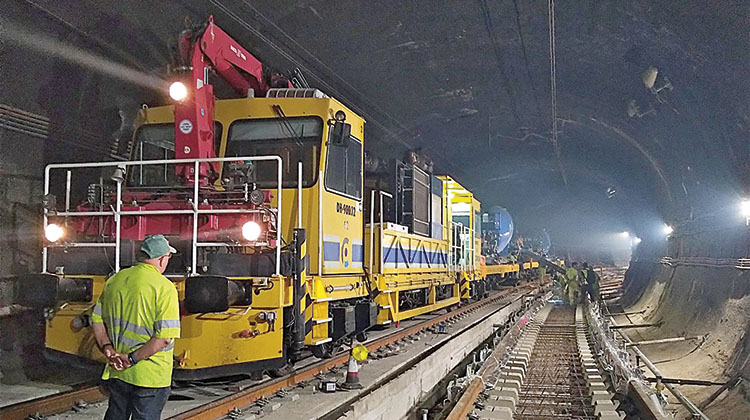 6. Additional work carried out included the installation of 25 new track devices: 7 turnouts, 8 crossovers and 1 bretelle. In the image, at the entrance of Nuevos Ministerios, one of the turnouts that has already been assembled; in the tunnel vault, supports for the new rigid overhead line.
6. Additional work carried out included the installation of 25 new track devices: 7 turnouts, 8 crossovers and 1 bretelle. In the image, at the entrance of Nuevos Ministerios, one of the turnouts that has already been assembled; in the tunnel vault, supports for the new rigid overhead line. 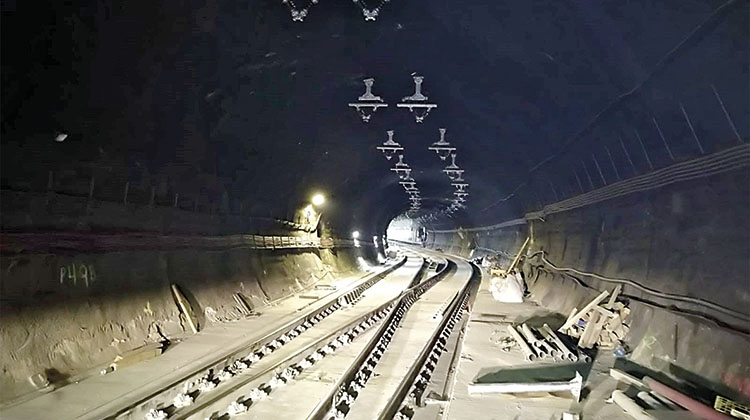 7. Assembly of part of the 1,300 rigid catenary bars installed in the tunnel.
7. Assembly of part of the 1,300 rigid catenary bars installed in the tunnel. 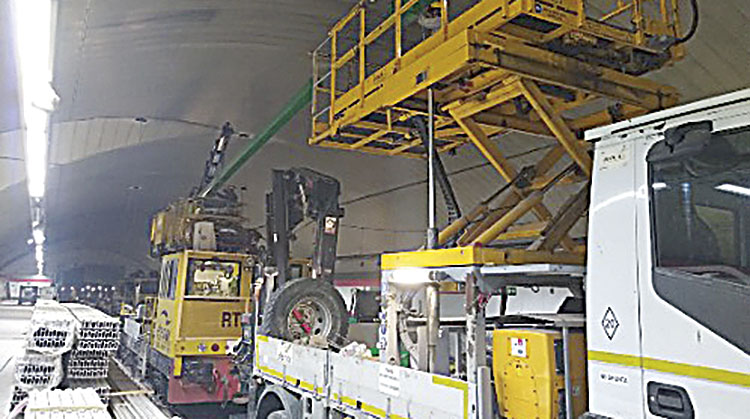 8. The completed track, with the rigid overhead line already installed.
8. The completed track, with the rigid overhead line already installed. 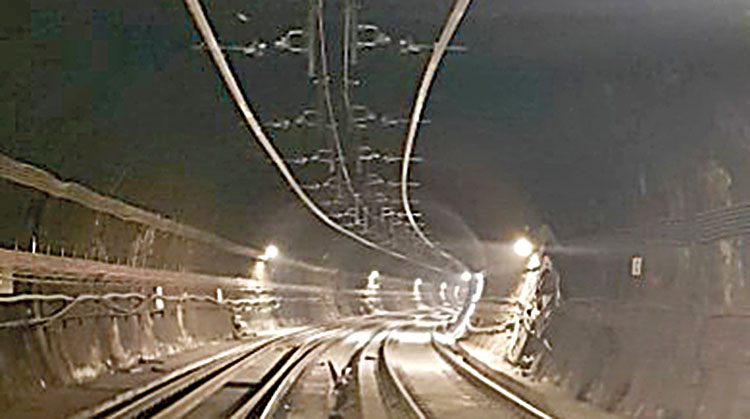 9. Running of new signals, wiring and signalling elements.
9. Running of new signals, wiring and signalling elements. 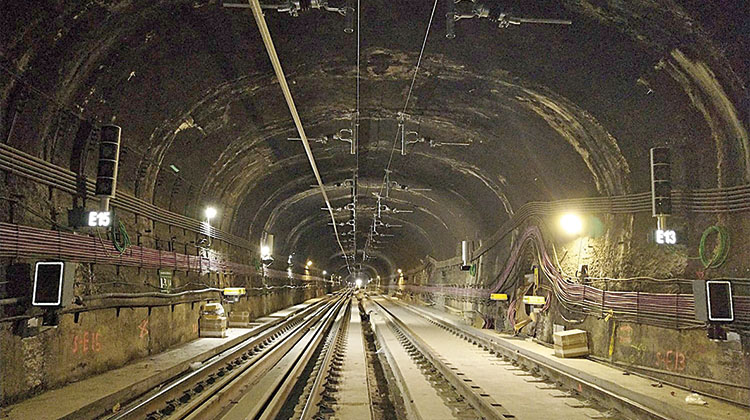 10. Electronic signalling control points were installed in the Recoletos and Nuevos Ministerios stations, upgrading the existing technology to a safer system.
10. Electronic signalling control points were installed in the Recoletos and Nuevos Ministerios stations, upgrading the existing technology to a safer system. 